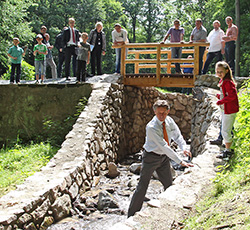Nature Conservation and Biodiversity
WACKER promotes biodiversity, taking account of local conditions. Its environmental-protection efforts to conserve resources and reinstate habitat help maintain the balance of species. Burghausen’s Site Planning unit develops strategies for limiting land use.
We carefully assess the impact that site expansions may have on nature and biodiversity and – in consultation with the authorities – implement environmental mitigation programs to offset these impacts. Take the expansion of our polysilicon production facilities at Burghausen and Nünchritz, for example. For every tree felled during construction of the new polysilicon production facility on the now 1.3-km2 Nünchritz site, we plant a new one.
Covering 232 hectares (about the same size as Munich’s historic downtown district), our Burghausen site borders a Natura 2000 nature reserve alongside the Salzach river. To check whether the operation of our facilities has any effect on this reserve, we regularly monitor our air pollution levels. In this regard, we had an external consultant compile an environmental-exposure register for the site. The results show that emissions into the atmosphere at the site do not significantly impact the nature reserve.
A group of employees at our US site in Adrian (Michigan) has set up nesting boxes for various species of bird and maintains a 2.4-km nature trail. The 97-hectare site premises also feature wildflower and butterfly gardens. For its dedication to nature and wildlife conservation, the Adrian team was once again awarded the US Wildlife Habitat Council’s 2011 Wildlife at WorkSM certificate, which is valid for three years.
Stream Re-Naturalized and Fish Ladder Installed

At the dedication for the newly constructed fish ladder, children from the “Schwalbennest” day nursery in Nünchritz placed paper boats and water lilies they made themselves into the flowing water. Wolfgang Semmler, head of Environmental Protection and Safety at Nünchritz, helped scoop them out again.
WACKER has installed a fish ladder on the Bockau, a small river in the Seusslitzer Grund Nature Reserve. The project was carried out in 2012 in close cooperation with several German nature conservation associations, including NABU (Nature and Biodiversity Conservation Union), environmental agencies and the Nünchritz municipal authorities. Its purpose was to restore the ecological passability of the Bockau. The €100,000 project offset a wetland biotope near the Nünchritz plant that had to give way to expansion of the production site.
The course of the Bockau in Seusslitzer Grund has been re-naturalized over a distance of sixty meters. A so-called rock ramp fish ladder has been built where a two-and-a-half-meter high obstacle had interrupted the free flow of water. The fish can now pass upstream through the gently sloped ladder. The passageway also makes it possible for many other kinds of animals to once again populate the Bockau River. These include endangered species such as the brook lamprey, an eel-like vertebrate now rarely seen in Germany. Seusslitzer Grund has also become a suitable habitat for brook trout, fire salamanders and freshwater shrimp – the conservation area conforms to the EU Fauna and Flora Habitats Directive (Nature Directive 92/43/EEC).